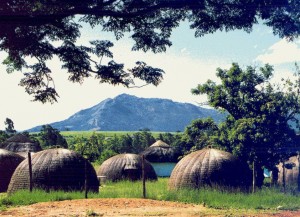- Swaziland, one of the smallest countries in Africa, is almost enclosed within South Africa, sharing just the northern half of its eastern border with Mozambique. Its population of 1.13 million (2006) is distributed over an area of 17,370 km2.
- Between 75% and 83% of the annual rainfall comes from October to March. Precipitation ranges from 500 mm in the south-east to 1,500 mm in the west, the average being 1,200 mm.
- Swaziland has five principle river basins (the Lomati, Komati, Mbuluzi, Great Usutu and Ngwavuma) whose total annual renewable water resources amount to 4.5 billion m3. Of this, 42% or 1.87 billion m3 originates in South Africa.
- The seasonal nature of the rainfall makes discharge of surface waters extremely variable. In dry areas such as the Lowveld, while the larger rivers are through-flowing, most watercourses tend to flow only after heavy local rainstorms. Hence, development of groundwater resources is crucial. Although no quantitative assessment of groundwater resources has yet been undertaken, the annual potential is estimated at 0.66 billion m3.
- Agriculture is the main consumer of freshwater resources, accounting for almost 97% of withdrawal. Of this, over 90% is used in growing sugarcane as the main cash crop. The country is split between largely rain-fed subsistence production by smallholders and cash cropping on large private estates.
- In the past, ad hoc management of water resources prevailed in Swaziland. Carried out by several ministries and by institutions outside the government, it involved multiple laws aimed at solving disparate issues.
Today the 2003 Water Act provides guidelines on how the water sector in Swaziland is coordinated. It establishes the National Water Authority, which is the highest policy-making body responsible for the development and management of the national water sector.
The section “Did You Know…?” is taken from the 3rd World Water Development Report “Water in a Changing World“.


